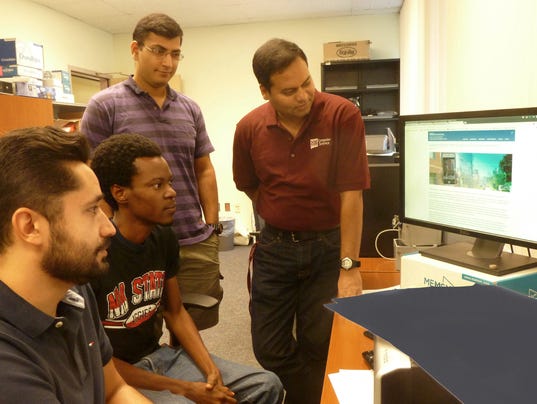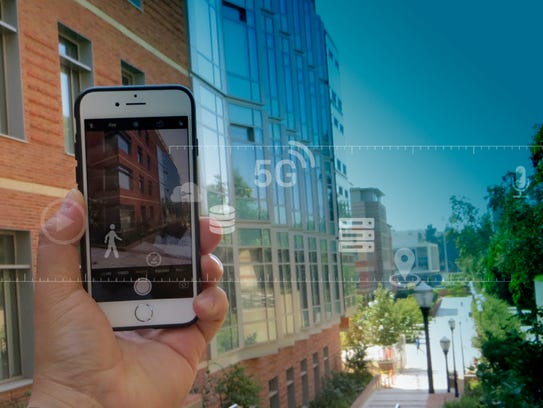NMSU professor working on new wireless networks
Source: Minerva Baumann
 A New Mexico State University professor is working with researchers from UCLA to integrate augmented reality into new wireless edge networks thanks to a $2 million grant from the National Science Foundation and Intel Corporation.
A New Mexico State University professor is working with researchers from UCLA to integrate augmented reality into new wireless edge networks thanks to a $2 million grant from the National Science Foundation and Intel Corporation.
The ICN-Enabled Secure Edge Networking with Augmented Reality project builds on seven years of research from the NSF-funded Named Data Networking project.
Satyajayant Misra, associate professor of computer science in the College of Arts and Sciences and a co-principal investigator, explained the project aims to develop augmented reality applications using Named Data Networking as a foundation. NDN is a new Internet architecture, under development by a multi-campus research team led by UCLA, with the potential to address the limitations in performance, scalability and availability of the current TCP/IP architecture, currently the basic communication language of the Internet. The project aims to enable wireless networks at the edge of the Internet to support futuristic augmented reality applications to be used by the public on a large scale.
Artist’s concept of smart phone using augmented reality

Artist’s concept of smart phone using augmented reality connecting with surroundings. (Photo: Graphic by UCLA Engineering)
Augmented reality, or AR, can offer smart phone users a richer experience, overlaying the real world with data, sounds, video and images from multiple sources to create new navigation, education, entertainment and other experiences as well as new possibilities for industrial, medical and defense applications.
“Today’s Internet relies on network location of data, while AR implementations depend on cloud computer servers, which could be located anywhere in the world,” said Misra, an expert in security and privacy who will lead the investigation of the security and privacy challenges for the team. “A main hurdle that prevents AR from becoming widespread is the existing architecture of the Internet, which at more than 40 years old, is not ideal for a new way of “browsing the world” through AR: An ideal AR experience is location-specific, individualized for each user and built from many diverse sources of content in near real-time.
“Security and privacy have been implemented into most systems on the Internet as an afterthought,” Misra added. “With this project, we address the S&P challenges from the inception of system design. This project provides unique challenges: AR applications require high data bandwidth and data delivery low latency. Thus, strong S&P protocols have to be designed, some from ground up, that are seamlessly woven into the system but also have little negative effects in terms of performance.”
NDN enables devices to directly interact with their surroundings through requesting desired data by names, over any and all available communication channels. For example, an AR application in a museum could allow patrons to engage with interactive exhibits, while another application might help first responders to move through a damaged building. In both cases, the AR applications should be able to access local sensors and other devices through any available wireless channels, without dependence on the Internet infrastructure. Current AR implementations require connecting to Internet servers, which adds both unnecessary delay and dependency on Internet connectivity for an otherwise local data exchange. Instead, NDN would keep local communication local, uncompromised by remote failures, in secure, fast and efficient ways.
“A fully realized AR environment would not be too far from what science fiction movies have depicted, as many of the necessary components are emerging, including both very high speed wireless technologies and advanced applications such as AR, ” said Lixia Zhang, UCLA’s Jon Postel Chair in Computer Science and the lead principal investigator on the project. “However currently, a major bottleneck in the way is the existing network architecture. We want to use this project to showcase how our newly developed NDN architecture can fully utilize the latest wireless technologies to support AR and promote innovative new applications.”
Other co-principal investigators on the project include Jeff Burke, associate dean for technology and innovation at the UCLA School of Theater, Film and Television along with UCLA computer science professors: Songwu Lu and Mario Gerla, both are experts in wireless computing and networking; and Jason Cong, who brings expertise on customizable computing architectures as the director of the NSF-funded Center for Domain Specific Computing. Another co-investigator is Alex Afanasyev, a former UCLA computer scientist who recently joined the Florida International University faculty.
| }
|